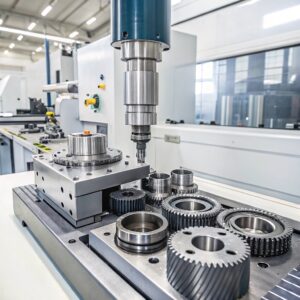Rotary encoders help you measure the position of a rotating shaft, but they work differently depending on the type. Incremental rotary encoders track relative position changes by generating pulses as the shaft moves. They need a reference point to determine the exact position. Absolute rotary encoders, on the other hand, assign a unique code to every shaft angle. For example, an 8-bit absolute encoder can provide 1024 distinct values, ensuring precise positioning without requiring a reference. Choosing between these encoders depends on your application’s accuracy needs and budget.
Key Takeaways
- Incremental rotary encoders measure position changes using small signals. They need a starting point to find the exact position.
- Absolute rotary encoders give a specific position for every angle. They keep position data even if the power goes out.
- Use incremental encoders for cheaper tasks that need speed control. They work well when exact positioning is not very important.
- Pick absolute encoders for jobs needing high accuracy. They are great for robots and machines that need to be very precise.
- Think about your task’s needs, like the environment and detail level, to pick the best encoder for good results.
What is an Incremental Rotary Encoder?
Definition
An incremental rotary encoder is a device that measures changes in position as a rotating shaft moves. It generates pulses that represent the relative movement of the shaft. Unlike absolute rotary encoders, it does not provide a unique position value for every angle. Instead, it tracks how far the shaft has moved from a reference point. For example, if the encoder produces 100 pulses per rotation, each pulse corresponds to 1/100th of a full turn.
Functionality
Incremental rotary encoders work by using a disc with evenly spaced slots or patterns. As the disc rotates, light or magnetic signals pass through these slots. The encoder converts these signals into digital pulses. These pulses indicate the shaft's movement and direction. However, the encoder needs a reference point to determine the exact position. After a power loss, you must reset the encoder to a "home" position before it can track movement again. This makes incremental encoders ideal for applications where relative position changes are more important than absolute positioning.
Key Features
Incremental rotary encoders offer several key features that make them versatile and efficient:
- Output Signals: They generate two square wave signals, known as quadrature output, to track position and direction.
- Resolution: The resolution depends on the number of pulses per rotation (PPR). Some encoders can achieve resolutions up to 20,000 PPR.
- Channels: Many encoders include a third channel for zeroing or homing the device.
- Sensing Technology: Optical sensing is commonly used, where a transparent disc with opaque sections creates the pulses.
- Environmental Ratings: Some models, like the HS35iQ, offer ratings up to IP67, making them suitable for harsh environments.
These features make incremental encoders a cost-effective choice for applications requiring precise tracking of relative motion.
What is an Absolute Rotary Encoder?
Definition
An absolute rotary encoder is a device that provides a unique position value for every angle of a rotating shaft. Unlike incremental encoders, it does not rely on a reference point to determine position. Instead, it assigns a specific digital code to each shaft position. For example, a 12-bit absolute encoder can distinguish 4,096 unique positions per turn. This capability ensures precise and reliable position tracking, even after power interruptions.
Functionality
Absolute rotary encoders operate by using a disc with concentric rings of binary patterns. Each ring corresponds to a bit in the digital output. As the shaft rotates, sensors read these patterns and generate a unique binary code for each position. This code directly represents the shaft's absolute position.
These encoders excel in applications where precision and reliability are critical. They maintain position data even during power loss, allowing immediate resumption of operations without recalibration. Additionally, they support multiple output protocols, making them compatible with various electronic systems.
Absolute rotary encoders also offer higher resolution compared to incremental types. For instance, they can achieve resolutions of up to 25,000 points per turn, making them ideal for tasks requiring fine motion control.
Key Features
Absolute rotary encoders come with several standout features:
- Precise Position Reporting: They provide exact position data at all times, eliminating the need for recalibration.
- Power Loss Recovery: These encoders retain position information during power outages, ensuring seamless recovery.
- High Resolution: They offer higher resolution than incremental encoders, with some models reaching up to 25,000 points per turn.
- Multiple Output Protocols: Support for various protocols allows easy integration with different systems.
- Accurate Motion Detection: They can detect motion along multiple axes with exceptional accuracy.
| Feature | Absolute Encoders | Incremental Encoders |
|---|---|---|
| Position Reporting | Provides exact position at all times | Requires additional calculations for position |
| Power Loss Recovery | Resumes immediately upon power restoration | Needs at least one full turn to provide data |
| Cost | Higher upfront cost due to more components | Lower initial cost but potentially higher long-term costs due to maintenance |
| Resolution | Higher resolution with unique codes | Limited resolution based on pulse count |
| Application Suitability | Ideal for precise positioning applications | Suitable for speed measurement but less precise for position |
These features make absolute rotary encoders a top choice for applications requiring high precision and reliability.
Key Differences Between Incremental and Absolute Rotary Encoders
Functionality Comparison
Incremental and absolute rotary encoders differ significantly in how they operate. Incremental encoders measure relative movement by generating pulses as the shaft rotates. These pulses indicate changes in position but require a reference point to determine the exact location. For example, after a power outage, you must reset the encoder to a "home" position before it can resume tracking.
In contrast, absolute rotary encoders provide a unique position value for every shaft angle. They use binary patterns to assign a specific code to each position, allowing them to retain position data even during power loss. This feature makes absolute encoders ideal for applications where maintaining position information is critical, such as in safety systems or robotics.
| Feature | Incremental Encoders | Absolute Encoders |
|---|---|---|
| Position Reporting | Requires reference point | Provides exact position at all times |
| Power Loss Recovery | Needs reinitialization | Retains position data |
Accuracy and Precision
When it comes to precision, absolute rotary encoders have the upper hand. They offer higher resolution by assigning unique codes to each position, enabling precise tracking even in complex systems. For instance, some absolute encoders can achieve resolutions of up to 25,000 points per turn, making them suitable for tasks requiring fine motion control.
Incremental encoders, while accurate for speed and relative position tracking, depend on the number of pulses per rotation (PPR) for resolution. High-PPR models can achieve good precision, but they still fall short compared to the unique coding system of absolute encoders. If your application demands exact positioning, absolute encoders are the better choice.
Cost and Complexity
Cost and complexity often play a significant role in choosing between these two encoder types. Incremental encoders are generally less expensive due to their simpler design. However, their reliance on external systems for position calculation can lead to higher long-term costs, especially in applications requiring frequent recalibration.
Absolute rotary encoders, while more expensive upfront, offer greater reliability and lower maintenance costs. They eliminate the need for reinitialization after power loss, saving time and resources. Their added complexity, including advanced components and protocols, justifies the higher price for applications requiring precision and reliability.
| Feature | Incremental Encoders | Absolute Encoders |
|---|---|---|
| Upfront Cost | Lower | Higher |
| Long-term Costs | Potentially higher due to maintenance | Lower due to reliability |
| Complexity | Simpler design | More complex with advanced features |
Tip: If your application prioritizes cost efficiency over precision, incremental encoders might be the right fit. For high-stakes tasks requiring accuracy and reliability, absolute encoders are worth the investment.
Typical Applications
Rotary encoders play a vital role in various industries, but their applications differ based on the type of encoder. Understanding where each type excels can help you choose the right one for your needs.
Incremental Rotary Encoders
Incremental encoders are ideal for applications that prioritize speed control and relative position tracking. These encoders work well in systems where re-syncing after power loss is acceptable. You will often find them in:
- Cut-to-Length Systems: Ensures precise cutting of materials like paper, metal, or textiles.
- Conveyor Control: Tracks the speed and movement of conveyor belts in manufacturing or packaging lines.
- Auger Control: Monitors the rotation of augers in agricultural or industrial equipment.
- Milling Machines: Measures relative positions during machining processes.
These applications benefit from the cost-effectiveness and simplicity of incremental encoders, especially when absolute positioning is not critical.
Absolute Rotary Encoders
Absolute encoders excel in applications requiring constant knowledge of the exact position. They are perfect for scenarios where precision and reliability are essential. You might encounter them in:
- Press Machines: Tracks the position of the press head for accurate operations.
- Assembly Machines: Ensures precise alignment and positioning during assembly processes.
- Dam Control Systems: Monitors and adjusts the position of gates for water flow management.
- Oil Valve Control: Maintains exact valve positions in oil and gas systems.
Additionally, absolute encoders are indispensable in high-precision fields like surgical robotics and advanced assembly lines, where even minor errors can have significant consequences.
| Encoder Type | Typical Applications |
|---|---|
| Incremental Encoders | Cut-to-Length, Conveyor Control, Auger Control, Milling Machines |
| Absolute Encoders | Press Machines, Assembly Machines, Dam Control, Oil Valve Control |
By matching the encoder type to your application, you can achieve optimal performance and efficiency. Incremental encoders suit tasks focused on speed and relative movement, while absolute encoders shine in precision-critical environments.
Pros and Cons of Incremental Rotary Encoders
Advantages
Incremental rotary encoders offer several benefits that make them a popular choice across industries. Their cost-effectiveness stands out as a key advantage. These encoders are relatively inexpensive, making them ideal for budget-conscious projects without compromising on performance.
Another notable benefit is their high resolution. Incremental encoders can provide precise measurements of position and movement, which is essential for applications requiring accurate speed and direction tracking. Additionally, their reliability ensures dependable performance in various environments, even under challenging conditions.
| Advantage | Description |
|---|---|
| Cost-effectiveness | Incremental encoders are relatively inexpensive compared to other types, making them ideal for budget-conscious projects. |
| High resolution | They provide higher resolution, allowing for more accurate measurement of position and movement. |
| Reliability | Despite some drawbacks, they are favored in various industries for their dependable performance. |
These advantages make incremental encoders a practical choice for applications where relative position tracking and affordability are priorities.
Disadvantages
While incremental rotary encoders have many strengths, they also come with limitations. They may not be suitable for applications requiring absolute position feedback, as they rely on a reference point to determine position. This can pose challenges in systems where power interruptions occur frequently.
High-resolution requirements can also be a hurdle. Incremental encoders may struggle to meet the demands of applications needing extremely fine precision. Sensitivity to motor shaft run-out and axial movement can lead to inaccuracies, especially in high-performance systems.
Other challenges include:
- Optical encoders may experience significant play, which affects performance.
- Resolutions exceeding 50,000 counts per turn can reflect bearing noise as position error.
- Thermal mismatches in bearing assemblies can degrade both performance and lifespan.
These disadvantages highlight the importance of carefully evaluating your application’s needs before choosing an incremental encoder.
Pros and Cons of Absolute Rotary Encoders
Advantages
Absolute rotary encoders offer several technical advantages that make them indispensable in precision-critical applications. One of their standout features is their ability to provide a unique positional value for every possible position. This ensures that even after a power interruption, the encoder retains the exact position without requiring a reference point. This capability eliminates downtime and enhances operational efficiency.
These encoders also excel in precision and reliability. They assign a distinct digital code to each position, ensuring accurate position retention during power loss. Their reliability meets stringent safety and redundancy requirements, making them ideal for critical sectors like robotics, CNC machines, and medical devices.
| Advantage | Description |
|---|---|
| Precision | Absolute encoders provide a distinct digital code for each position, ensuring accurate position retention during power loss. |
| Reliability | They meet stringent safety and redundancy requirements, enhancing system reliability in critical sectors. |
| Application Performance | Ideal for CNC machines, robotics, and medical devices due to their high precision and accuracy. |
Additional benefits include higher resolution compared to incremental encoders, better startup performance due to low homing time, and accurate motion detection along multiple axes. These encoders also support multiple output protocols, allowing seamless integration with various electronic systems.
Tip: If your application demands precision and reliability, absolute rotary encoders are an excellent choice.
Disadvantages
Despite their many advantages, absolute rotary encoders come with some drawbacks. Their complexity contributes to higher initial costs compared to incremental encoders. This is due to the increased number of components and advanced technology required for their operation.
The mechanical complexity of these encoders can also lead to more frequent maintenance needs. Over time, this may affect their overall cost-effectiveness, especially in applications where maintenance downtime is critical.
- Higher initial costs due to advanced components.
- Increased maintenance requirements can impact long-term affordability.
- Mechanical complexity may lead to occasional performance losses.
While these disadvantages may seem significant, they are often outweighed by the benefits in applications where precision and reliability are non-negotiable.
How to Choose the Right Encoder for Your Application
Factors to Consider
When selecting the right encoder, you need to evaluate several key factors to ensure it meets your application’s requirements. Start by considering the environmental conditions. For example, industrial settings with dust, oil, or vibrations may require sealed encoders, while clean environments like semiconductor manufacturing benefit from exposed encoders for higher accuracy.
Next, assess the type of feedback your system needs. Incremental encoders provide pulse-based feedback, making them suitable for speed control. Absolute encoders, on the other hand, deliver unique position data, ensuring precise tracking.
You should also evaluate the motion type—rotary or linear—and the interface compatibility with your control system. Additionally, think about the resolution required. Incremental encoders vary in pulses per revolution, while absolute encoders offer higher resolutions for detailed motion control.
Tip: Always match the encoder’s specifications to your application’s environmental and performance needs to avoid unnecessary costs or inefficiencies.
Choosing between incremental and absolute rotary encoders depends on your specific needs. Each type offers unique advantages:
- Incremental encoders work best for applications requiring cost efficiency and relative position tracking. They are ideal for tasks like speed control and simple motion monitoring.
- Absolute encoders excel in precision-critical applications. They provide exact positioning, even after power loss, making them perfect for robotics, CNC machines, and safety systems.
Tip: Evaluate your application’s requirements for accuracy, budget, and complexity. This ensures you select the encoder that delivers the best performance for your system.
FAQ
What is the main difference between incremental and absolute rotary encoders?
Incremental encoders measure relative movement by generating pulses, while absolute encoders provide a unique position value for every shaft angle. Incremental encoders need a reference point to determine position. Absolute encoders retain position data even after power loss, making them more reliable for precision tasks.
Which encoder is better for high-precision applications?
Absolute rotary encoders are better for high-precision applications. They offer higher resolution and provide exact position data at all times. This makes them ideal for robotics, CNC machines, and safety-critical systems where accuracy is essential.
Are incremental encoders more cost-effective than absolute encoders?
Yes, incremental encoders are generally more cost-effective. Their simpler design results in lower upfront costs. However, they may require additional maintenance or recalibration, which could increase long-term expenses depending on the application.
Can absolute encoders work in harsh environments?
Yes, many absolute encoders are designed for harsh environments. They often feature robust housings and high IP ratings, protecting them from dust, moisture, and vibrations. Always check the encoder’s specifications to ensure compatibility with your environment.
How do you choose between incremental and absolute encoders?
Consider your application’s needs. Choose incremental encoders for cost efficiency and speed tracking. Opt for absolute encoders if you need precise positioning, power-loss recovery, or compatibility with complex systems. Evaluate factors like resolution, budget, and environmental conditions before deciding.







